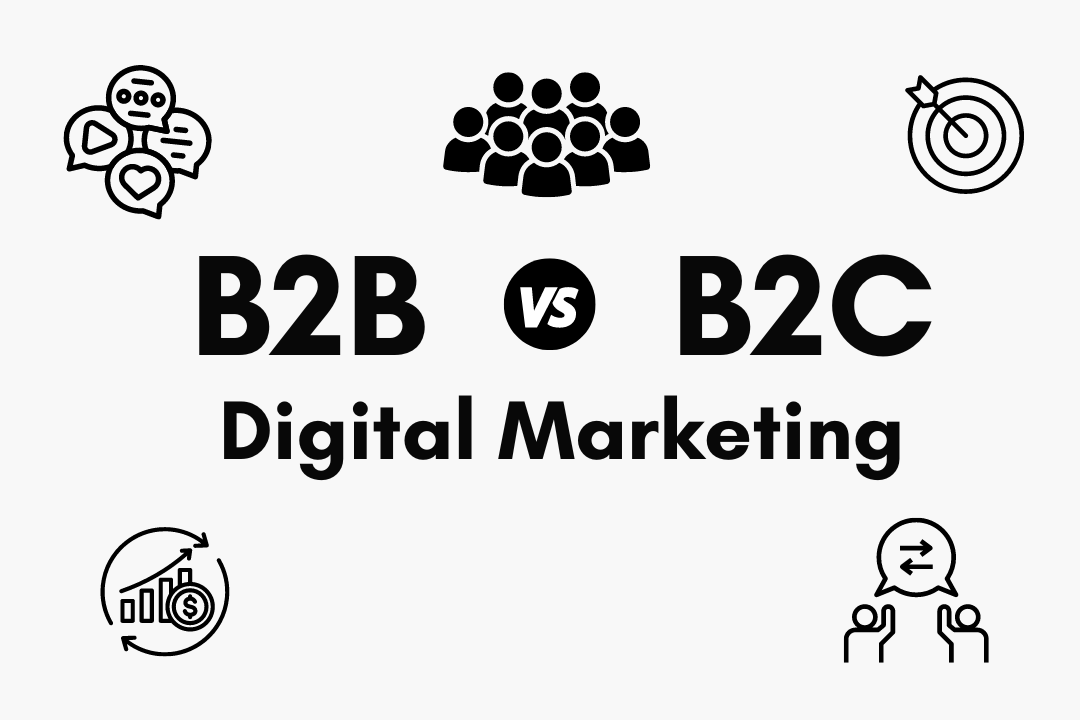In the fast-paced digital world, understanding the nuances between B2B and B2C digital marketing can be the difference between soaring success and missed opportunities.
Today, businesses are leveraging digital marketing more than ever, but the strategies for B2B (Business-to-Business) and B2C (Business-to-Consumer) differ significantly.
This blog post dives into these differences, offering insights to help you tailor your marketing strategies effectively.
What is digital marketing?
Digital marketing encompasses all marketing efforts that use an electronic device or the internet. Businesses leverage digital channels such as search engines, social media, email, and other websites to connect with current and prospective customers.
Examples of digital marketing include:
- SEO (Search Engine Optimization): Optimizing website content to rank higher in search engine results.
- PPC (Pay-Per-Click) Ads: Paid advertisements that appear at the top of search engine results.
- Email Marketing: Sending targeted emails to potential and existing customers.
- Social Media Marketing: Promoting products or services through social media platforms.
Benefits of digital marketing:
- Cost-Effective: Digital marketing is generally more affordable than traditional marketing.
- Measurable Results: Track and measure the success of campaigns in real time.
- Targeted Reach: Target specific demographics and audiences.
- Increased Engagement: Foster engagement through interactive and direct communication channels.
What is B2B digital marketing?
B2B digital marketing refers to strategies and practices used by businesses to sell products or services to other businesses. The goal is to reach decision-makers and stakeholders within other companies.
What is B2C digital marketing?
B2C digital marketing involves strategies that businesses use to sell products or services directly to consumers. The focus is on appealing to individual customers’ needs and preferences.
Main differences between B2B and B2C digital marketing
Target audience
B2B target audience:
- Decision-makers: The primary audience includes managers, executives, and business owners who are responsible for making purchasing decisions on behalf of their organizations.
- Focus on logic: These individuals base their decisions on logical reasoning and data. They prioritize return on investment (ROI), efficiency, and strategic benefits that can enhance their business operations.
B2C target audience:
- Individual consumers: The target audience consists of individual buyers looking for products or services for personal use.
- Emotional appeal: Consumer decisions are often driven by emotions, desires, and personal benefits. Marketing messages aim to resonate on a personal level, highlighting how a product or service can improve their daily lives.
Marketing goals
B2B marketing goals:
- Building long-term relationships: The goal is to establish and maintain strong relationships with other businesses. This involves consistent engagement and trust-building over time.
- Lead generation and nurturing: B2B marketing focuses on generating high-quality leads and nurturing them through a structured sales funnel. This involves multiple touchpoints and personalized communication.
B2C marketing goals:
- Driving immediate sales: The primary objective is to convert prospects into customers quickly. This often involves limited-time offers and promotions to encourage immediate purchases.
- Increasing brand awareness and loyalty: B2C campaigns aim to create a strong brand presence and foster customer loyalty through engaging content and positive experiences.
Decision-making process
B2B decision-making process:
- Complex and lengthy: The process involves multiple stakeholders, including procurement teams, financial advisors, and department heads. Each stakeholder has specific criteria and concerns that need addressing.
- Detailed information: Decisions require comprehensive information, including technical specifications, case studies, and ROI analysis. The emphasis is on making informed, risk-averse choices that benefit the entire organization.
B2C decision-making process:
- Short and impulsive: Consumers often make quick decisions based on immediate needs, preferences, and emotions. Impulse buying is common.
- Influenced by trends: Consumer choices are influenced by trends, social proof, and peer recommendations. Visual appeal and emotional triggers play significant roles.
Content strategy
B2B content strategy:
- In-depth and educational: Content is designed to inform and educate. Examples include white papers, eBooks, case studies, webinars, and detailed blog posts.
- Industry expertise: The focus is on demonstrating industry expertise and offering solutions to specific business problems. Content should help build credibility and authority.
B2C content strategy:
- Engaging and entertaining: Content aims to captivate and entertain the audience. This includes videos, social media posts, blog articles, and infographics.
- Trends and lifestyle: Content often reflects current trends and lifestyle choices, appealing to the consumer’s personal interests and aspirations.
Sales cycle
B2B sales cycle:
- Longer duration: The sales cycle is typically longer due to the complexity of the products/services and the need for multiple approvals.
- Multiple touchpoints: It requires numerous touchpoints, such as meetings, presentations, and follow-up communications. Each stage of the sales funnel needs careful attention and nurturing.
B2C sales cycle:
- Shorter duration: The sales cycle is usually shorter and more straightforward. Customers are often ready to make a purchase immediately after discovering a product.
- Quick conversions: Strategies focus on quick conversions through clear calls to action, limited-time offers, and easy checkout processes.
Communication Style
B2B communication style:
- Professional and formal: The tone is typically experienced, emphasizing clarity, precision, and formality. The language used is more technical and industry-specific.
- Informative: Communication is detail-oriented and focused on providing valuable information that aids decision-making.
B2C communication style:
- Casual and conversational: The tone is more relaxed and conversational. Marketers aim to build a personal connection with the audience.
- Engaging: The focus is on creating engaging, relatable content that resonates with the consumer’s emotions and interests.
Channels and platforms
B2B channels and platforms:
- LinkedIn and professional networks: LinkedIn is a key platform for B2B marketing, along with industry-specific forums and websites.
- Email marketing and webinars: Email campaigns and webinars are effective for nurturing leads and providing in-depth information.
B2C channels and platforms:
- Social media platforms: Platforms like Facebook, Instagram, and TikTok are crucial for reaching consumers. These channels are ideal for visual and interactive content.
- Influencer marketing and video content: Collaborating with influencers and creating compelling video content can significantly boost engagement and reach.
Effective B2B digital marketing strategies and channels
Search engine optimization (SEO)
- Increasing Visibility: SEO is crucial for B2B businesses to enhance their online presence. By optimizing their website and content for search engines, businesses can improve their rankings on search engine results pages (SERPs), making it easier for potential clients to find them.
- Targeted Keywords: Focusing on industry-specific keywords helps attract high-quality traffic. These keywords should reflect the terms and phrases that decision-makers in the industry are likely to search for.
- Informative Content: Creating informative and valuable content, such as blogs, articles, and resource pages, not only helps with SEO but also positions the business as an industry leader. Content should address common pain points and provide solutions.
Pay-per-click ads
- Precise Targeting: Pay-per-click (PPC) advertising allows B2B companies to target specific businesses and industries effectively. Platforms like LinkedIn and Google Ads offer advanced targeting options based on job titles, company size, and industry.
- Ad Formats: Utilize various ad formats, such as search ads, display ads, and retargeting ads, to reach potential clients at different stages of the buying process. Tailor the ad copy to highlight the unique value propositions and solutions your business offers.
Email marketing
- Relationship Building: Email marketing is a powerful tool for building and maintaining relationships with prospects and clients. Personalized, value-driven content can help nurture leads through the sales funnel.
- Segmentation: Segmenting your email list based on criteria such as industry, company size, and position allows for more targeted and relevant communication. Send tailored content that addresses the specific needs and interests of each segment.
- Automation: Implementing email marketing automation can streamline your efforts, ensuring timely follow-ups and consistent engagement. Automated workflows can be used for lead nurturing, onboarding, and post-purchase follow-ups.
Content marketing
- Educational Content: Publishing high-quality content such as white papers, case studies, and detailed blog posts can demonstrate your expertise and provide value to potential clients. This type of content helps educate decision-makers about industry trends, challenges, and solutions.
- Thought Leadership: Regularly producing thought leadership content can establish your brand as an authority in your industry. Participate in industry discussions, share insights, and offer unique perspectives to build credibility.
- Distribution Channels: Utilize various distribution channels to amplify your content reach. Share your content through social media, email newsletters, and industry publications to ensure it reaches your target audience.
Effective B2C digital marketing strategies and channels
Social media marketing
- Broad Reach: Social media platforms like Facebook, Instagram, and TikTok are essential for reaching a wide audience. These platforms offer diverse advertising options and sophisticated targeting capabilities.
- Visual Content: Engage users with visually appealing content, including images, videos, and infographics. Visual content tends to capture attention quickly and can convey messages effectively.
- Interactive Elements: Incorporate interactive elements such as polls, quizzes, and live streams to increase engagement. These features encourage users to interact with your brand, fostering a sense of community and loyalty.
Influencer marketing
- Credibility and Reach: Partnering with influencers can help build brand credibility and expand your reach. Influencers have established trust with their followers, making their endorsements highly effective.
- Authenticity: Choose influencers whose values align with your brand. Authentic endorsements resonate more with audiences and can significantly influence purchasing decisions.
- Campaign Types: Implement various influencer marketing campaigns, such as sponsored posts, product reviews, and giveaways. Track the performance of these campaigns to optimize future efforts.
Video marketing
- Compelling Storytelling: Video marketing is an effective way to capture and retain attention. Create compelling videos that tell a story and connect with viewers on an emotional level.
- Platform Optimization: Tailor your video content for different platforms, such as YouTube, Instagram, and TikTok. Each platform has unique features and audience preferences, so customize your approach accordingly.
- Engagement Metrics: Monitor key engagement metrics like views, likes, shares, and comments to gauge the effectiveness of your video content. Use these insights to refine your video marketing strategy and improve future content.
Conclusion
Understanding the differences between B2B and B2C digital marketing is crucial for crafting effective strategies.
B2B marketing focuses on building relationships and providing detailed, data-driven content, while B2C marketing aims to engage and convert consumers quickly through emotional and entertaining content.
Tailor your approach to your target audience and leverage the appropriate channels to maximize your marketing efforts.
For businesses looking to enhance their digital marketing strategies, reach out to us at Pillars Media. Let’s elevate your marketing game and drive your business forward.

